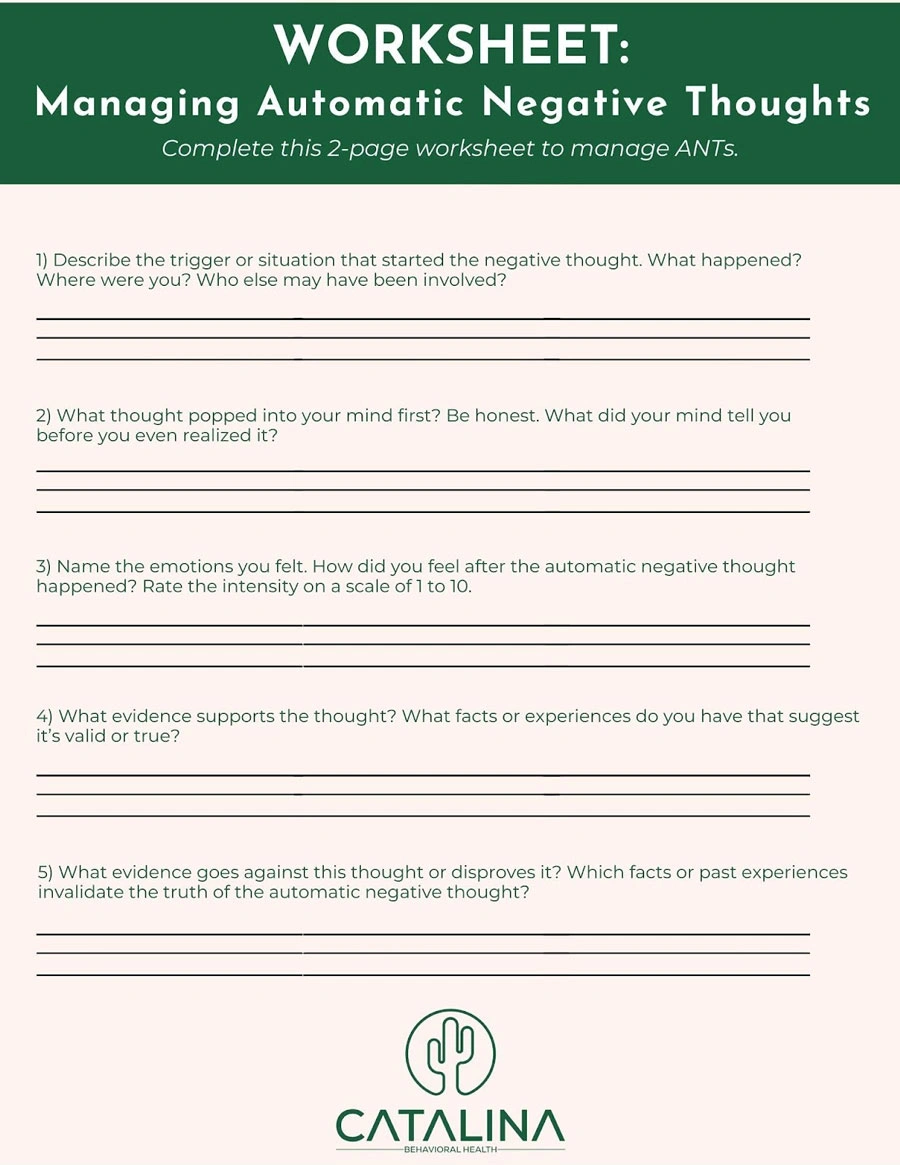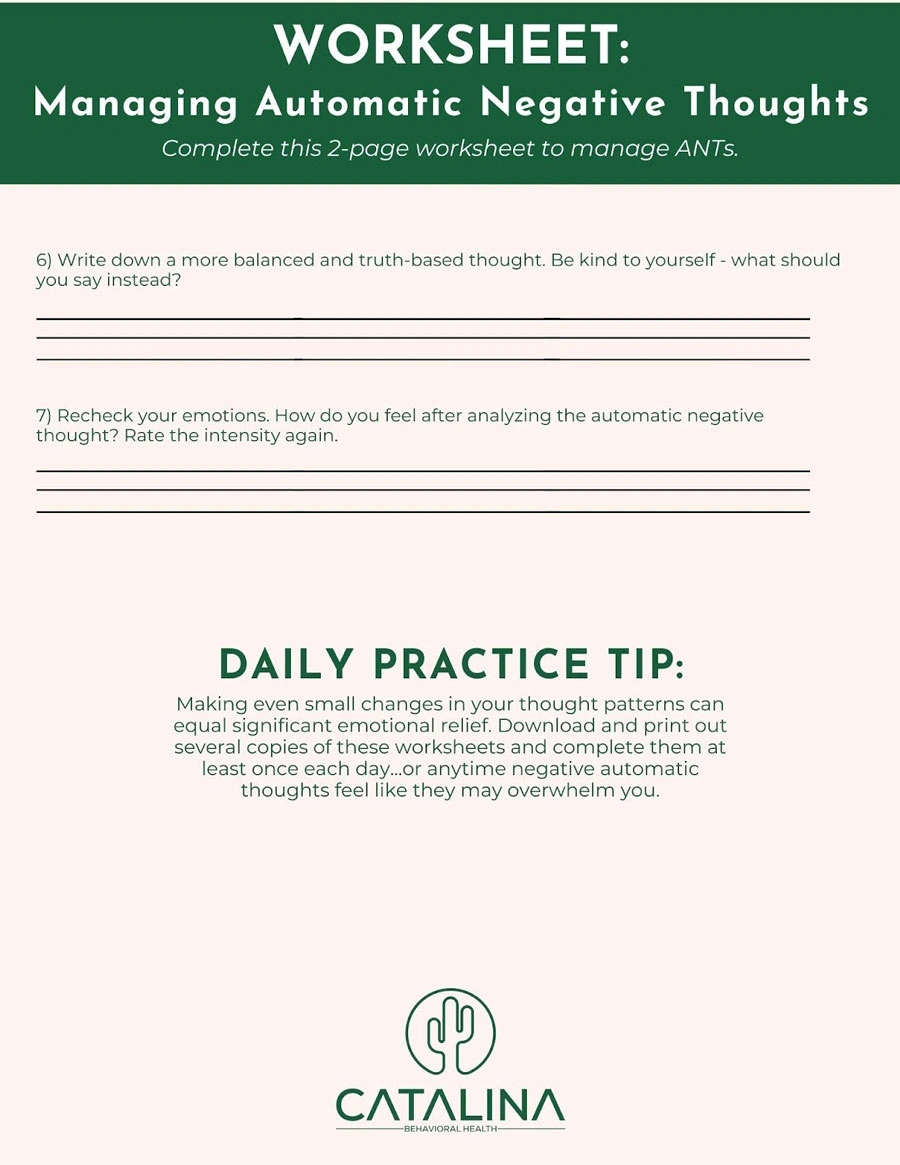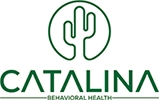Worksheets to Help You Work Through Negative Thinking Patterns
Automatic negative thoughts can pop into your mind without warning, making you feel doubts or anxiety about yourself, your situation, or your future. These thought patterns are unhelpful cognitive distortions. Still, they become automatic responses in many, especially for the person who struggles with particular mental health concerns.
Located in Tucson, Arizona, the Catalina Behavioral Health team can support clients as they learn to exchange automatic negative thoughts that destroy mental health with helpful thoughts. Our counselors and therapists guide clients through the process using multiple evidence-based resources.
If automatic negative thoughts are holding you back from living life to the fullest, it’s time to replace them. Our downloadable exercise can help you identify your negative thoughts and help you shift to positive thinking instead.
Get Confidential Trauma and Mental Health Assessment
Automatic Negative Thoughts Worksheet: A Simple Tool to Transform Your Thinking
Our worksheet helps people identify automatic negative thoughts so that they can deal with them once and for all. Cognitive restructuring is a psychology principle developed by Aaron Beck. It often includes completing CBT worksheets and exercises. Therapists lead clients through a series of prompts or questions to help them learn their negative thoughts and then identify opportunities to change them.
If you need to work on increasing your self-awareness of automatic negative thoughts, our CBT worksheet can help. However, CBT worksheets are always most effective when used in conjunction with a professional therapist. Share the completed material with your therapist or counselor. If you don’t have one, please feel free to contact Catalina Behavioral Health for assistance.
How to Use This Worksheet for Negative Automatic Thoughts
Each step of the CBT worksheet leads you to consider a question. Focus on the first response, your gut reaction to the prompt. Be honest with yourself as you complete this CBT activity.
Follow Our Example of a Client Using Our CBT Resource

As you learn about each CBT worksheet prompt, you’ll see an example response from ‘Mateo,’ a college student and retail store employee who struggles with anxiety.
His anxiety stems from childhood abandonment, but the effect of his automatic thoughts continually leads him down the road of worsening symptoms.
# 1: Describe the Trigger or Situation
This first worksheet question helps you identify any situations or conditions that may lead you to jump to the worst conclusions automatically. These are your triggers. Where were you? Who was with you?
Mateo’s trigger: I was in the break room at work, eating lunch, when my manager walked in and whispered something to a coworker. She didn’t speak to me.
#2: Write Down the First Thought That Popped into Your Mind
The next prompt challenges you to explore the thought patterns that geared up in response to the trigger. What did your mind tell you in that moment?
Mateo’s initial automatic thought: She’s talking about me. I’ve made a mistake, and now I’m in trouble.
#3: Name the Emotions You Felt and Rate Them
In the third section of the automatic thoughts worksheet, you’ll recognize and name the emotions you felt in the moment. You’ll also identify and rate the intensity of your emotions, rating them on a scale of 1 to 10 (with 10 being the highest score.
Mateo’s emotions: Anxiety – 9; Embarrassment – 7; Shame – 6; Fear – 8
#4: Look for Evidence That Supports Your Thought
You start to question the ANT in #4; it may feel like a silly activity, but it’s necessary to complete this step so you can challenge and change the thoughts through cognitive restructuring. Do you have any proof that the negative automatic thought is true? What facts back up its validity? If you identify any evidence, write it down in this section.
Mateo supports his automatic thoughts: I completed the project she assigned me a day late. She seemed frustrated with me and has been short with me ever since. She didn’t acknowledge me when she walked in, and she just whispered to the other person without speaking to me.
#5: Challenge the Thought with Any Evidence You Have Against It
Now, you’ll identify any evidence that challenges the automatic thought pattern and prove it untrue. What evidence goes against this thought or disproves it? Which facts or past experiences invalidate the truth of the automatic negative thought?
Mateo challenges his ANTs: My manager has been under stress and has been short in how she deals with all the college students working here lately. She also thanked me for finishing the project. I don’t know what she whispered to the other person in the break room – could’ve been anything – maybe she didn’t notice me sitting there.
# 6: Write Down a More Balanced, Truth-Based Thought

Now that you’ve identified and challenged the ANT, it’s time to replace the harmful automatic thoughts with more optimistic thinking. Write down a more balanced, truth-based, factual statement. Notice how you speak to yourself and be kind.
Mateo’s more balanced thought: I don’t know what my manager said to my co-worker. I shouldn’t assume it was about me – and probably wasn’t about me at all! I’ve been doing my best at work, and one late project doesn’t erase all my other efforts.
# 7: Recheck Your Emotions and See What Changed
Finally, the cognitive restructuring worksheet challenges you to recheck your emotions after you’ve replaced negative thoughts with a more positive statement. How do you feel after analyzing the automatic thoughts? Rate the intensity of your emotions again on the same 1 to 10 scale.
Mateo’s emotions after reframing his automatic thoughts: Anxiety – 4 ; Embarrassment – 3; Shame – 2; Calm – 6
Daily Practice: Make This Cognitive Restructuring Worksheet Part of Your Mental Wellness Routine
Making even small changes in your thought patterns can equal significant emotional relief. Download and print out several copies of these CBT worksheets and complete them at least once each day…or anytime you notice negative automatic thoughts that seem like they may overwhelm you.
When you practice regularly, you hone your skills and learn to recognize and manage your negative thinking patterns more efficiently. Some past clients have explained that they eventually look forward to using this resource every day, with some who even find it fun.
What Are Automatic Negative Thoughts and Where Do They Come From?

ANTs are unfiltered, usually unconscious thoughts. They come as a response to everyday events or feelings, but they blow them out of proportion. Also called cognitive distortions, they’re pessimistic, incredibly self-critical, or based in fear.
An example is someone who receives a neutral suggestion from their supervisor at work and automatically thinks they might lose their job, even when there is no evidence to support this thought pattern.
Automatic thoughts arise from someone’s life experiences, emotions, and beliefs. Those who carry childhood trauma or who have not developed resilience against failures are more likely to experience negative automatic thoughts. The thought patterns eventually become automatic, with the brain defaulting to these lies without trying to identify if they’re true.
Different Types of Automatic Negative Thoughts (ANTs)
There is more than one type of negative automatic thought. Once you can identify cognitive distortions, you take the first step toward the ability to tackle them. Here are some of the primary types of automatic negative thoughts clients may experience:
- Catastrophizing, or assuming the worst outcome is the most likely one. This ANT increases anxiety and blocks problem-solving by making the world feel hopeless or uncontrollable. Example: If I mess up this one project, I’ll lose everything I’ve worked so hard to earn.
- Mind reading occurs when someone believes they know what others think. These automatic thoughts lead to self-doubt; they assume one knows the thoughts of others, even when they don’t. Example: She doesn’t like me and thinks I’m annoying.
- All or nothing thinking, or seeing everything in black or white with no expressions of gray in the middle. This ANT challenges making progress. It fails to recognize the small steps needed to make permanent changes and disregards the effort that goes into the process. Example: I’ve regained 2 pounds; I’m worthless.
- Personalization, in which someone blames themself for things outside of their control. These automatic thoughts are a challenge because they create feelings of excessive guilt. It places an enormous emotional burden where it doesn’t really belong. Example: It’s my fault my friend is upset. (Friend is actually upset about a fight with their significant other.)
- Labeling, or defining oneself by a single bad experience. This automatic thought reinforces a negative self-image; it fails to recognize the positive accomplishments and focuses only on mistakes or negativity. Example: I’m a total failure.
A constant focus on the negative gives the person a low opinion of both self and the world around them.
How ANTs Fuel Anxiety, Depression, and Low Self-Esteem
Automatic negative thoughts, when left untreated, can become a constant source of worry and self-judgment. That worsens anxiety, depression, bipolar disorder, and other mental health conditions. The problem doesn’t lie in the thoughts alone.
Instead, the negative information becomes ingrained in the person’s belief system. They begin accepting the unhelpful thoughts, giving the negative thinking even more power over them.
The Role of Positive Thinking and Self-Talk in Reshaping Mental Patterns

Positive thinking is essential in healing the damage caused by ANTs. Still, positive thoughts must be grounded in truth and self-compassion. The practice of cognitive restructuring, part of the CBT psychology technique, helps people change negative thoughts into positive ones – our worksheet activity is just one example.
Catalina Has the Resources to Treat ANTs and Restore Balance
When you receive professional mental health treatment at Catalina Behavioral Health, we will assess your symptoms and guide you through various CBT exercises and other evidence-based therapies and resources to help you achieve positive thoughts. This concept becomes a helpful tool that you’ll carry for life.
Up To 100% of Rehab Costs Covered By Insurance
Seek Effective Treatment for Automatic Negative Thoughts
Do negative thoughts affect your well-being and disrupt your relationships? The Catalina Behavioral Health team can help you rid your brain, setting you free from the lies you’ve told yourself. Our admissions representative will take time to gather information about you and your automatic negative responses, which helps make treatment decisions.
Our admissions team can also help you control the price of treatment for those using private or group insurance. They’ll contact your insurance plan for you and help you access all the resources necessary for better mental health.
Contact Catalina confidentially today – it’s time to start living a life free of negative automatic thoughts.





